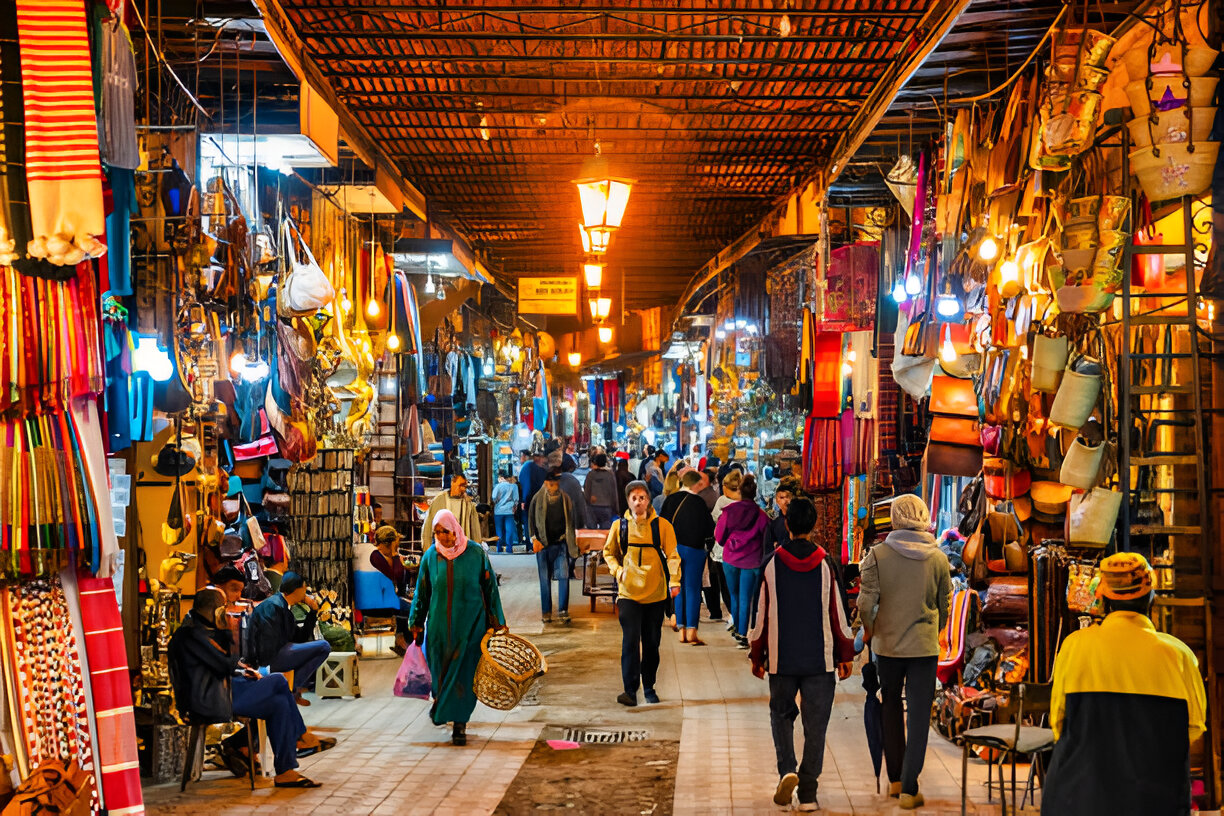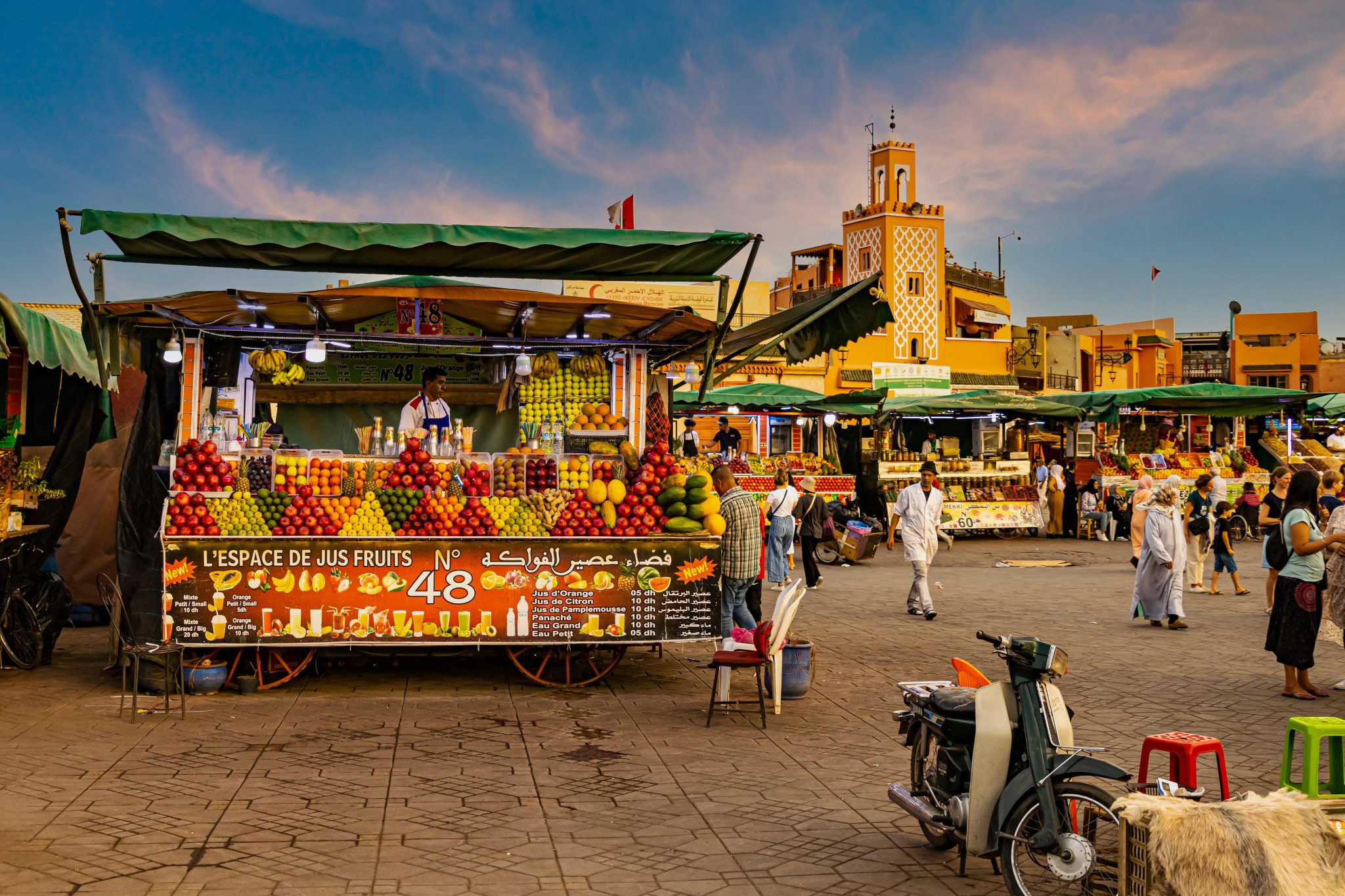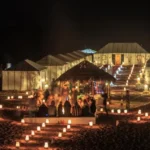Welcome to Marrakech. The name itself conjures images of bustling souks, exotic spices, and ancient palaces, making it a cornerstone of unforgettable Morocco vacation tours. But to truly understand this city, to let it become a part of you, you must experience it with more than just your eyes. Many visitors planning their holidays in Morocco come with a checklist—Jardin Majorelle, Bahia Palace, Koutoubia Mosque—and while these are magnificent landmarks, they are only single notes in a complex and beautiful symphony. The real magic of Marrakech isn’t just in what you see; it’s in what you hear, smell, taste, and touch.
This is not just another travel guide; this is an invitation. An invitation to step beyond the surface and embark on a Marrakech sensory tour, a journey designed to awaken every one of your senses. We believe this is the definitive experience, whether you have 2 days in Marrakech or are starting a longer adventure. This article will guide you through the philosophy of sensory travel and then take you on a deep dive into the sights, sounds, smells, tastes, and textures that make Marrakech a living, breathing entity, a highlight of any morocco holiday guide.
The Philosophy of Immersive Travel: Why Your Senses Are the Best Guides
In our fast-paced world, travel has often been reduced to a race for the perfect Instagram photo. We collect destinations like badges, often experiencing them through the tiny screen of a smartphone. This checklist tourism creates a disconnect, leaving us with beautiful images but shallow memories. In contrast, our approach ensures you see the landmark but also feel the soul of the place—the subtle hum of its daily life, the ancient stories carried on the breeze, the authentic flavours that tell a story of their own.
Indeed, immersive, sensory travel is the antidote. It’s a mindful approach that encourages you to slow down and be present. It’s about engaging with your environment using all the faculties you possess. When you actively notice the symphony of sounds in a busy square, the intricate blend of aromas from a spice market, or the texture of a hand-woven carpet, you are creating deep, multi-layered memories. Consequently, these are the memories that last a lifetime, long after the social media likes have faded. Marrakech, with its glorious and unfiltered assault on the senses, is arguably the world’s greatest classroom for this profound way of traveling.
I. The Visual Feast (SIGHT): Painting Your Perception of Marrakech
Your sensory exploration begins with sight, the most immediate and overwhelming of the senses in Marrakech. The city is a masterpiece painted with a palette so rich and varied it can feel like stepping into another world. In fact, it’s a visual journey that goes far beyond simple observation, inviting you to see the stories hidden in the colours, the light, and the architecture that surrounds you on any marrakech city tour.
From the moment you arrive, you’ll understand why Marrakech is called the “Red City” or “Ochre City.” The ancient ramparts, the traditional homes, and the very earth itself are saturated in a warm, terracotta hue that shifts in intensity from a soft rose at dawn to a deep, fiery red at sunset. This consistent backdrop, as a result, makes the explosion of other colours within the city walls even more spectacular and visually arresting.

A Kaleidoscope of Colour in the Medina
The red of the city walls is merely the canvas. Within the Medina, you’ll find a riot of colour that is both chaotic and harmonious. The souks are the epicentre of this visual feast. For instance, imagine stalls overflowing with vibrant babouches (leather slippers) arranged in perfect rainbows—yellow, cobalt blue, fuchsia, and emerald green. Furthermore, piles of spices create pyramids of earthy reds, bright yellows, and rich browns, their colours as potent as their aromas.
Further in, you’ll find the lamp souk, a magical cavern where hundreds of handcrafted lanterns cast intricate patterns of light and shadow. The lamps themselves are works of art, fashioned from metal pierced with complex geometric designs and fitted with panes of dazzling coloured glass. Then there are the carpets, with Berber artisans weaving stories into textiles using deep indigos, bold reds, and natural, creamy wools. Each colour, in essence, tells a tale of a tribe, a region, or a family tradition.
The Intricate Beauty of Moroccan Architecture
If you look beyond the bustling markets, your eyes will feast on some of the most intricate architectural details in the world. The true beauty of Marrakech is often hidden behind unassuming wooden doors. Step inside a traditional riad, and you’ll find a serene courtyard, a hidden oasis where the visual language changes from the chaos of the streets to one of tranquil, geometric perfection.
Here, your eyes will be drawn to zellij, the stunning mosaic tilework that adorns walls, floors, and fountains. Millions of tiny, hand-cut tiles are pieced together to form breathtakingly complex star-shaped patterns and flowing Arabic calligraphy. Moreover, if you look up, you may see intricately carved cedarwood ceilings or delicate mashrabiya screens, wooden latticework designed to filter the harsh sunlight into a soft, ethereal glow. Places like the Bahia Palace and the Ben Youssef Madrasa are masterclasses in this art form, where every surface is a testament to the skill and patience of generations of craftsmen.
II. The Symphony of the Souks (SOUND): An Auditory Journey
Once you acclimate to the visual splendour, close your eyes for a moment and just listen. The soundscape of Marrakech is a complex, multi-layered symphony that is as integral to its identity as the red of its walls. It’s a city that is constantly in motion, and its sounds tell the story of its commerce, its faith, and its people. Subsequently, this auditory journey is a vital part of any true Marrakech sensory tour.
The most profound and unifying sound is the adhan, the Islamic call to prayer. Five times a day, the voice of the muezzin rings out from the minaret of the Koutoubia Mosque and countless other neighbourhood mosques, echoing through the alleyways. It is a hauntingly beautiful sound that momentarily brings the city to a collective pause. Regardless of your beliefs, the call to prayer serves as a powerful, rhythmic punctuation to the day, connecting the present moment to centuries of tradition.

The Rhythms of Commerce and Craft
As you delve into the souks, the soundscape becomes more intricate. You’ll hear the constant, friendly buzz of commerce. For example, there’s the rhythmic chant of vendors calling out their wares, the good-natured back-and-forth of haggling, and the clinking of coins. This isn’t just noise; it’s the sound of a living economy, a tradition of trade that has thrived in these same alleyways for a thousand years. Listen closely for the specific sounds of creation.
Specifically, in the metalworkers’ souk (souk haddadine), you will hear the sharp, rhythmic tink-tink-tink of hammers shaping metal into intricate lamps and trays. In the woodworkers’ area, meanwhile, the whirring of a lathe and the gentle scraping of hand tools create a softer, more organic tune. These are not the sounds of a factory; they are the sounds of skill, patience, and artistry. Each tap of the hammer is a note in the symphony of craftsmanship that defines the Medina.
The Music and Voices of Djemaa el-Fna
As evening approaches, all sounds gravitate towards the grand stage of Djemaa el-Fna. Here, the auditory experience reaches its crescendo. You will be enveloped by a dozen different performances happening all at once. Most notably, the hypnotic, cyclical rhythms of Gnaoua musicians, with their clacking iron castanets (qraqeb) and deep, resonant guembri (a three-stringed bass lute), create a trance-like atmosphere.
Nearby, a circle might form around a traditional storyteller, his voice rising and falling with dramatic flair as he captivates an audience with ancient Berber tales. Likewise, you’ll hear the high-pitched piping of the snake charmer’s flute, the powerful beat of Berber drums accompanying acrobats, and the laughter of children. This cacophony is not chaos; it is the vibrant, unfiltered sound of Moroccan culture, a living museum of performance and tradition that you can’t read about in a book—you must hear it to believe it.
III. The Aromatic Heart of Morocco (SMELL): A Tapestry of Scents
The sense of smell is powerfully linked to memory, and the scents of Marrakech will stay with you long after you’ve returned home. The city’s air is a complex perfume, a constantly shifting blend of exotic spices, fragrant foods, sweet perfumes, and earthy, ancient odours. To truly take a Marrakech sensory tour is to follow your nose down alleyways and into hidden courtyards, letting the city’s aromas guide you.
The most dominant and alluring scents, of course, emanate from the spice souks (rahba kedima). Here, you will find mountains of fragrant powders and dried herbs. Your senses will be awakened by the sharp, pungent aroma of cumin, the warm, sweet scent of cinnamon, the bright, peppery notes of ginger, and the rich, earthy fragrance of turmeric. In addition, you’ll discover ras el hanout, the famous Moroccan spice blend whose name means “head of the shop,” a complex mixture of up to 50 different spices that is unique to each vendor.

From Sizzling Tagines to Sweet Perfumes
Beyond the spice markets, the entire Medina is an open-air kitchen. Follow the tantalizing smell of lamb and prunes simmering slowly in a clay tagine pot over hot coals. Let the scent of freshly baked khobz (round, flat bread) lead you to a communal neighbourhood oven (furan), where families have been bringing their dough for centuries. In Djemaa el-Fna at night, the air becomes thick with the smoke and sizzle of the outdoor food stalls, grilling everything from spicy merguez sausages to succulent kebabs.
Interspersed with these savoury smells are waves of sweetness and floral notes. The ubiquitous scent of fresh mint, often piled high on carts, is never far away, promising a refreshing glass of Moroccan mint tea. Similarly, you’ll catch the delicate, intoxicating perfume of orange blossom and jasmine wafting from the hidden gardens of a riad. In the herbalist shops, you can explore the rich, nutty aroma of pure argan oil, the sweet scent of amber blocks, and the medicinal fragrances of countless dried herbs and remedies that have been part of Berber culture for millennia.
The Earthy and the Unexpected
However, not all of Marrakech’s scents are sweet perfumes. To get a full, authentic olfactory picture of the city, one must also embrace its more primal smells. A visit to the tanneries, for instance, is an unforgettable (and pungent) experience. The strong, ammoniac smell from the pigeon droppings used in the traditional leather-curing process is intense, but it is the raw, unfiltered smell of an ancient craft.
Similarly, the earthy scent of wet clay in the potters’ district or the dusty smell of the sun-baked ramparts are fundamental parts of the city’s character. These smells are honest and unfiltered. In truth, they are the scents of history, of labour, and of life itself. They ground you in the reality of the city, providing a stark but important contrast to the more perfumed aromas of the souks and gardens, completing the rich tapestry of scents that defines Marrakech.
IV. A Culinary Pilgrimage (TASTE): Savoring the Kingdom’s Flavors
Taste is perhaps the most rewarding sense to indulge in Marrakech. Moroccan cuisine is a delicious reflection of its rich history, a blend of Berber, Arab, Andalusian, and French influences that has been refined over centuries. To taste the food of Marrakech is to taste its culture, its hospitality, and its soul. This is more than just eating; it’s a culinary pilgrimage that will delight and surprise your palate at every turn.
The journey of taste begins with the national dish: the tagine. Named after the conical clay pot it’s cooked in, the tagine is a slow-simmered stew that is the epitome of Moroccan comfort food. The flavour combinations are endless and exquisite. For example, you might savour a classic lamb tagine with sweet prunes and toasted almonds, or a zesty chicken tagine with preserved lemons and green olives. The slow cooking process, as a result, makes the meat incredibly tender and allows the complex blend of spices—like saffron, ginger, and turmeric—to meld into a perfectly balanced, savoury-sweet masterpiece.
The Vibrant World of Moroccan Street Food
While tagines are a restaurant staple, the true taste of daily life is found on the streets. The Medina is a treasure trove of street food stalls, each offering a delicious and affordable speciality. Therefore, be adventurous and try b’stilla (or pastilla), a sweet and savoury pie with layers of flaky pastry, shredded chicken or pigeon, almonds, and a dusting of cinnamon and powdered sugar. It’s an unusual combination that is surprisingly delicious.
Furthermore, don’t miss maakouda, crispy fried potato cakes often served in a sandwich, or the smoky flavour of grilled merguez sausage. For the truly daring, the snail soup (ghoulal) served from bubbling cauldrons in Djemaa el-Fna is a local delicacy, with a rich, spiced broth believed to have healing properties. And of course, no visit is complete without a glass of the freshly squeezed orange juice sold from countless carts, a burst of pure, sweet sunshine.
The Ritual of Mint Tea and the Sweetness of Pastries
In Morocco, tea is more than just a drink; it’s a ritual and a symbol of hospitality. Known as “Berber whiskey,” Moroccan mint tea is a sweet, fragrant blend of green tea, a generous bunch of fresh spearmint leaves, and typically, a large amount of sugar. The tea is poured from a height into small, delicate glasses, a technique used to aerate the tea and create a frothy head, known as the “crown.” Ultimately, accepting a glass of tea is to accept a gesture of friendship.
To complement your tea, consider an exploration of Moroccan pastries. Shops and stalls display sticky, honey-drenched treats that are as beautiful as they are sweet. Try chebakia, a flower-shaped fried dough coated in honey and sesame seeds, especially popular during Ramadan. Alternatively, sample kaab el ghazal (“gazelle horns”), crescent-shaped pastries filled with a delicate almond paste and flavoured with orange blossom water. Each bite is a taste of celebration and tradition.
V. The Texture of a Timeless City (TOUCH): A Tactile Exploration
The final layer of your Marrakech sensory tour is an exploration of touch. It’s a sense we often overlook, but in a city built on craftsmanship and natural materials, touch provides a profound connection to your surroundings. From the smoothness of polished plaster to the roughness of a Berber carpet, the textures of Marrakech tell a story of artistry, nature, and time, a key feature of our shopping tours morocco.
Your tactile journey begins the moment you start walking. You’ll feel the unevenness of the ancient cobblestones beneath your feet in the Medina. As you navigate the narrow alleyways, you might brush your hand against the city’s walls and feel the unique texture of tadelakt. This traditional waterproof lime plaster, polished with river stones and olive oil soap, is incredibly smooth and cool to the touch, a surface that is both beautiful and functional, used in everything from palace walls to hammam steam rooms.
The Language of Fabrics and Leather
The souks are a playground for the sense of touch. Run your fingers over the impossibly soft leather of a pair of babouches or a handcrafted bag. Feel the satisfying weight and intricate tooling that speaks to the quality of the material. Venture into the carpet shops, and you will be invited to take off your shoes and walk across dozens of Berber rugs. In doing so, you’ll feel the difference between the thick, shaggy pile of a Beni Ourain rug from the mountains and the tightly woven, smoother texture of a colourful Kilim.
Moreover, discover the surprising feel of “vegetable silk,” or sabra, a fabric made from the fibers of the agave cactus. It is cool and incredibly smooth, used to make shimmering scarves, throws, and tablecloths. By touching these items, you connect directly with the materials and the immense human effort that went into transforming them from a raw state into a thing of beauty.
Connecting Through Food and Environment
The sense of touch is also integral to the culinary experience. Traditionally, many Moroccan dishes, like couscous and some tagines, are eaten with the right hand. Feeling the texture of the fluffy couscous grains as you roll them into a ball with vegetables and meat is a grounding, intimate way to connect with your food and the local culture. Also, feel the warmth of a freshly baked piece of khobz as you tear it apart to scoop up a delicious dip.
Finally, feel the environment itself. Experience the intense, dry heat of the midday sun on your skin, followed by the refreshing coolness of a shaded alleyway or a riad courtyard. Feel the fine mist from the water sellers’ brass cups in Djemaa el-Fna. Then feel the press of the crowd as you navigate the bustling square. These tactile sensations—from the heat of the sun to the texture of your food—complete your sensory immersion, grounding you fully in the physical reality of this incredible city.
VI. Your Guided Sensory Journey: Bringing It All Together
You can, of course, attempt to explore the senses of Marrakech on your own. But to truly unlock the city’s secrets and understand the deep context behind every sight, sound, and smell, a local guide is indispensable. In fact, a professional marrakech city tour guide is the key that unlocks the stories you would otherwise miss. Think of them not just as a navigator, but as an interpreter for your senses.
A great guide knows which food stall serves the most authentic maakouda. They can translate the dramatic tales of the storyteller in the square. They have personal relationships with the artisans, allowing you to move beyond a simple transaction and have a genuine conversation. All our marrakech guided tours are designed this way. Whether you’re on a grand tour or have a short 2 day itinerary marrakech, this guided experience transforms a great trip into an unforgettable one. Our Morocco Private Tours ensure this experience is personal and tailored just for you.
Practical Tips for Your Sensory Adventure
To make the most of your sensory exploration, keep a few things in mind. First, wear comfortable shoes, as you will be walking extensively on uneven surfaces. Second, carry small denominations of cash for purchases in the souk. When it comes to haggling, approach it with a smile and a sense of humour; it’s a friendly part of the culture, not a battle.
Most importantly, be open and respectful. If you wish to take a photo of a person or their shop, always ask for permission first. A simple gesture and a smile go a long way. By showing respect for the local culture, you will be welcomed with open arms, allowing for a much deeper and more authentic sensory immersion. This respectful approach is the cornerstone of all our Private Morocco tours.
VII. Beyond Marrakech: Extending Your Sensory Adventure Across Morocco
While Marrakech is a world unto itself, it is also the perfect gateway to the incredible diversity of Morocco. Many travelers use our sensory tour as the starting point for a longer journey, and we offer a wide range of itineraries to continue your exploration. Our morocco holiday packages are designed to showcase the best of the country, whether you have a few days or a few weeks.
For example, our Day Trips From Marrakech are immensely popular. You can experience a dramatic shift in scenery and senses with an agafay desert day trip from marrakech, feeling the vast silence and the unique texture of the stone desert. Alternatively, a trip to the 3 valleys morocco offers the scent of pine and juniper in the Atlas Mountains and the taste of a traditional Berber lunch. You can even journey from ait ben haddou from marrakech to see the iconic ksar, a true feast for the eyes.
Crafting Your Perfect Moroccan Itinerary
Our expertise extends across the entire country. Perhaps you’re planning a 7 day morocco tour; we can craft an itinerary that takes you from the bustling energy of the city on a journey from casablanca to sahara desert, experiencing the ultimate sensory contrast. Our Private Tours from Casablanca and Private Tours from Fes are perfect starting points for comprehensive explorations, including authentic Sahara Desert experiences. We also launch adventures from all major hubs, offering Private Tours from Tangier, Private Tours from Rabat, Private Tours from Ouarzazate, and Private Tours from Agadir.
We cater to every interest. For those seeking unique experiences, we design specialized journeys such as our respectful morocco jewish heritage tours, empowering Women only Trips, and wonderful Morocco Family Tours. We also offer niche adventures like Bird Watching in Morocco or tranquil Yoga in Morocco retreats. From Fes guided tours to a casablanca city tour, our goal is to help you build the perfect Morocco vacation.
Conclusion: The Experience That Becomes a Part of You
Marrakech is not a city to be simply observed; it is a city to be absorbed. A journey here is a potent reminder that the most profound travel experiences are those that engage every part of us. The memories you will take home won’t just be of colours and buildings, but of the taste of your first real tagine, the sound of the call to prayer at sunset, and the scent of mint and spices that will forever transport you back to these magical alleyways. This is the ultimate goal for your morocco holidays.
This is the promise of a Marrakech sensory tour. It is an invitation to slow down, to be present, and to let this incredible city awaken you. It’s an experience that weaves itself into your being, leaving you with a deeper understanding of Moroccan culture and a collection of memories so rich and vivid they will last a lifetime. Ultimately, our Morocco vacation tours are more than just trips; they are the stories you will tell for years to come.
Click Here to Book Your Unforgettable Morocco Tour and Awaken Your Senses!










